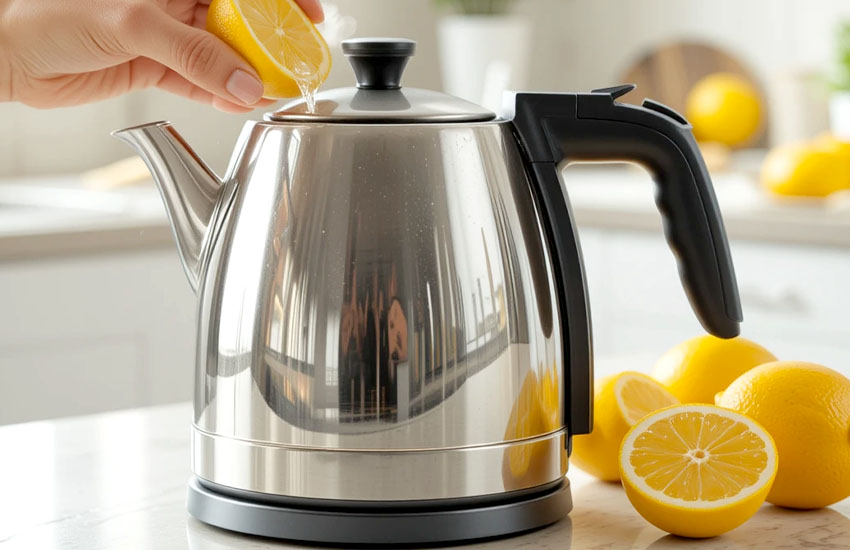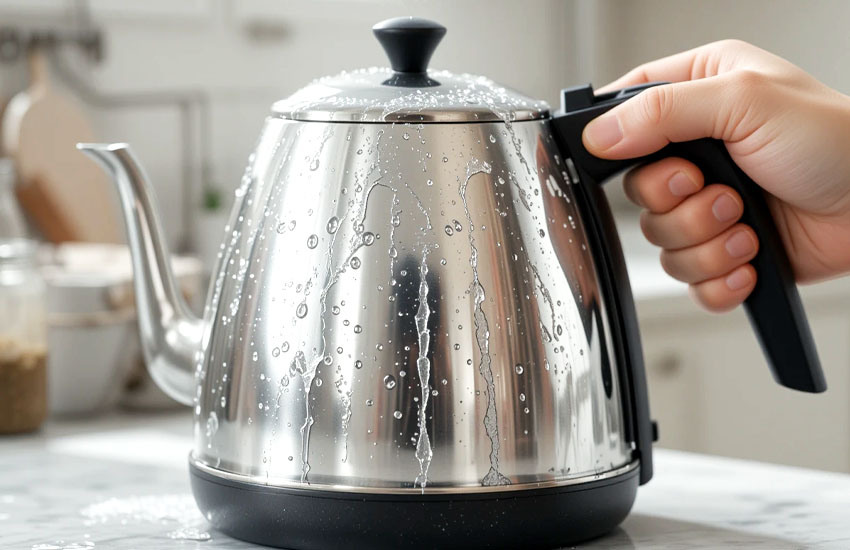We've all been there — staring at the ugly limescale buildup inside our kettles, wondering how to get rid of it without using harsh chemicals or expensive products. Well, have no fear because I’ve got a solution for you that's as simple as it is effective: using lemon! Yes, you heard that right. You can naturally descale your kettle using lemon, saving you money and keeping your kitchen eco-friendly. Stick around, and I'll show you exactly how to do it step by step, so your kettle will be sparkling in no time.

Why You Should Descale Your Kettle
When you boil water repeatedly in a kettle, mineral deposits from hard water begin to accumulate. This build-up, also known as limescale, forms a crusty layer that coats the heating element and the walls of your kettle. Over time, this affects the efficiency of your kettle, makes it harder to boil water, and can even shorten the lifespan of your appliance. Not only that, but limescale can also leave a nasty taste in your tea or coffee. So, it’s essential to descale your kettle regularly to keep it functioning properly.
While there are plenty of chemical descalers available on the market, many people prefer using natural alternatives. One of the most effective and eco-friendly methods is using lemon. The citric acid in lemon is a powerhouse when it comes to breaking down stubborn mineral deposits, making your kettle clean and fresh again without any harsh chemicals.
Let's dive in and explore how to use lemon to descale your kettle in just a few simple steps!
The Benefits of Using Lemon to Descale Your Kettle
1. Natural and Eco-friendly Solution
Using lemon to descale your kettle is a natural and chemical-free alternative. No need for store-bought descaling products, which may contain toxic chemicals or strong artificial fragrances. Lemon is a natural cleaner that's safe for you and the environment.
2. Cost-Effective
Lemons are inexpensive and readily available, which makes them a much more affordable option compared to bottled descalers or other specialty cleaning products. You can simply use a lemon you probably already have in your kitchen or buy one for just a few cents.
3. Fresh, Clean Smell
Let's be honest: those commercial descaling products often leave a strong chemical smell behind. When you use lemon, your kettle will not only be clean but will also smell fresh and citrusy, leaving behind a pleasant aroma instead of an artificial one.
4. Quick and Easy
Lemon is one of the easiest and quickest ways to descale a kettle. All you need to do is cut up a lemon, add it to some water, and let the citric acid do the hard work. It's a no-fuss, no-mess solution that works every time.
Now that we know why using lemon to descale your kettle is a great idea, let's jump into the step-by-step process!
How to Descale Your Kettle With Lemon: A Step-by-Step Guide
Step 1: Gather Your Materials
Before you begin the process, gather the necessary materials:
- 1 lemon (fresh or bottled lemon juice will work)
- Water
- A clean cloth or sponge (for wiping down the inside after descaling)
- A kettle (of course!)
This simple list ensures you're ready to go, and no extra tools are required. The simplicity of this method is one of the best parts!
Step 2: Prepare the Lemon
Now, you'll need to prepare your lemon. If you’re using a fresh lemon, cut it in half and squeeze out the juice. You can also cut it into slices or wedges. If you don't have a fresh lemon available, bottled lemon juice can be used as well. Typically, 1 to 2 tablespoons of lemon juice should suffice for most kettles, but feel free to adjust based on the size of your appliance.
Step 3: Fill the Kettle With Water
Fill your kettle with enough water to cover the areas where you see the limescale buildup. You don't need to fill it to the brim, just enough to make sure the descaling solution will reach the affected parts of the kettle.
Step 4: Add the Lemon Juice
Add the freshly squeezed lemon juice (or bottled lemon juice) into the water in your kettle. If you’re using lemon slices, add those directly to the water as well. The citric acid in the lemon is what will work to dissolve the minerals that have built up inside your kettle.
Step 5: Boil the Solution
Now, turn on your kettle and let it come to a boil. As the water heats up, the lemon juice will begin to break down the limescale inside the kettle. This boiling process helps loosen the mineral deposits, making it easier to wipe them away once the kettle cools down. Boiling also allows the steam to reach the harder-to-reach spots.
Step 6: Let it Sit
Once the kettle has boiled, turn it off and allow the lemon-water solution to sit for about 15–20 minutes. This will give the citric acid more time to break down the limescale. You may even notice some bubbling or fizzing action, which is a good sign that the solution is working!
Step 7: Scrub the Interior
After the kettle has cooled down a little, use a clean cloth or sponge to scrub the inside gently. The limescale should be soft and come off easily with minimal effort. If needed, you can use a non-abrasive sponge or brush for tougher spots. Be sure to focus on any areas with stubborn buildup, especially near the heating element.
Step 8: Rinse and Dry
Once you’ve scrubbed away the limescale, pour out the lemon water, and give the kettle a thorough rinse with fresh water. You might need to repeat the rinsing process a couple of times to ensure all the lemon juice is washed away, leaving no residue behind. Finally, wipe down the inside of the kettle with a clean, dry cloth to prevent any water spots.
That's it! Your kettle should now be free of limescale and smelling fresh. You'll notice an immediate improvement in your kettle's performance and maybe even in the taste of your tea or coffee!
Tips for Maintaining a Clean Kettle
Descaling your kettle with lemon is a great start, but you'll also want to maintain your kettle to avoid limescale buildup in the future. Here are some simple tips to help keep your kettle in top shape:
1. Use Filtered Water
Using filtered or soft water can significantly reduce the amount of limescale that builds up in your kettle. If you live in an area with hard water, consider using a water filter or a water softener to reduce the mineral content in your water.
2. Empty the Kettle After Use
When you're done boiling water, pour out the remaining water and leave the lid open to allow the kettle to air out. This helps prevent moisture buildup inside the kettle, which can contribute to limescale formation.
3. Regular Descaling
Descale your kettle regularly — at least once a month if you use it frequently. Regular cleaning helps prevent large limescale deposits from forming, making it easier to clean each time.
4. Avoid Leaving Water in the Kettle
Don't leave water in your kettle for extended periods, especially overnight. This creates the perfect environment for mineral deposits to build up. Always empty the kettle after use and rinse it out if needed.
By following these simple tips, your kettle will remain in great condition, and you won't have to worry about limescale ruining your day.
I hope this guide helps you to easily and effectively descale your kettle using lemon! It's a simple and natural way to keep your kettle in top shape, without the use of harsh chemicals or expensive products. With just a lemon, some water, and a little time, you can make your kettle look and perform like new. Happy descaling!

Frequently Asked Questions
Is it safe to descale my kettle with lemon?
Yes, using lemon to descale your kettle is completely safe. Lemon contains citric acid, which naturally breaks down mineral deposits without causing harm to the kettle.
Can I use lemon juice from a bottle?
Yes, bottled lemon juice works just as well as fresh lemon juice. Just make sure to use the right amount (about 1–2 tablespoons for most kettles) to get the best results.
Do I need to scrub the kettle after descaling with lemon?
After letting the lemon-water solution sit and boiling, you may need to scrub the kettle gently with a cloth or sponge to remove any remaining limescale.
Is it better to use hot or cold water when descaling?
You should use hot water for the descaling process, as heat helps to loosen the limescale and allows the citric acid in the lemon to work more effectively.
Can I use this method for all types of kettles?
Yes, this method is safe for most kettles, including electric and stovetop models. Just be sure to follow the manufacturer's instructions to avoid damaging the kettle.
Is there a quicker way to descale my kettle with lemon?
The process of boiling water and letting it sit for a few minutes is the most effective way to descale your kettle with lemon. However, if you're in a rush, you can reduce the time you let the solution sit, but it might not work as thoroughly.
Do I need to clean the kettle after descaling with lemon?
Yes, it's essential to rinse and wipe down the kettle after descaling to remove any leftover lemon juice or limescale residue.
Can I prevent limescale buildup in my kettle?
You can reduce limescale buildup by using filtered or soft water and regularly emptying and drying your kettle after use.